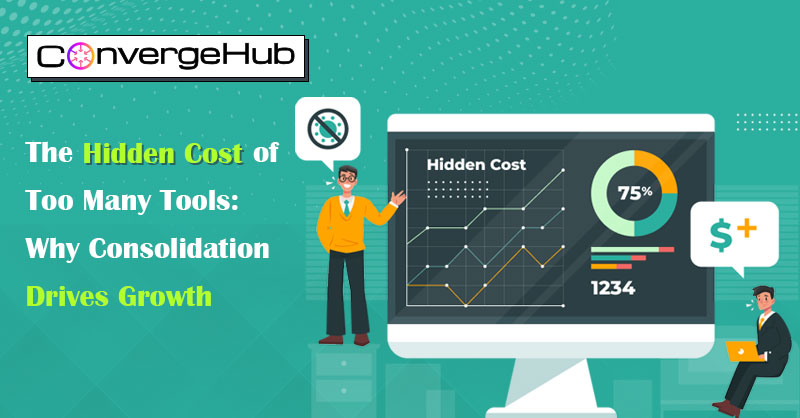
In the race to digitize, many businesses have embraced a “more is more” approach to software. A CRM for sales. A separate tool for email marketing. Another for customer support. Yet another for billing. Sprinkle in a few analytics dashboards, a project management app, and a help-desk system. Suddenly, your tech stack looks more like a tangled web than a streamlined engine.
While each tool may serve a purpose, the cumulative effect is often chaos. What starts as a quest for efficiency ends in fragmentation, frustration, and financial drain.
Welcome to the hidden cost of tool sprawl.
The Rise of Tool Sprawl: How We Got Here
The SaaS revolution made it easier than ever to adopt specialized tools. Need to automate emails? There’s an app for that. Want to track leads? Another app. Manage support tickets? Yet another.
This modularity seemed like a blessing, until it wasn’t.
As businesses scaled, so did their software stacks. But instead of working in harmony, these tools often operated in silos:
Each team optimized for their own needs, but the organization as a whole suffered from disjointed data, inconsistent messaging, and operational inefficiencies.
The Real Cost of Too Many Tools
Tool sprawl isn’t just a minor inconvenience, it’s a silent killer of productivity, profitability, and growth. Here’s how:
1. Subscription Overload
Every tool comes with a price tag. Multiply that by the number of users, departments, and overlapping features, and you’re looking at a bloated software budget. Worse, many businesses pay for tools they barely use—or use redundantly.
According to a 2024 SaaS management report, companies waste up to 30% of their software spend on unused or underutilized tools. That’s not just inefficient—it’s unsustainable.
2. Data Fragmentation
When customer data lives in multiple systems, it’s nearly impossible to get a unified view. Sales might see one version of a customer’s journey, while support sees another. Marketing may be targeting leads that sales already closed—or worse, lost.
This fragmentation leads to:
3. Workflow Friction
Switching between tools isn’t just annoying—it’s costly. Studies show that context switching can reduce productivity by up to 40%. Every time your team toggles between platforms, they lose focus, momentum, and time.
Add to that the complexity of managing integrations, syncing data, and troubleshooting errors, and your “tech stack” starts to feel more like a tech trap.
4. Training and Onboarding Overhead
Each tool has its own interface, terminology, and learning curve. Onboarding new employees becomes a maze of logins, tutorials, and tribal knowledge. Instead of ramping up quickly, new hires spend weeks just learning how to navigate your systems.
5. Security and Compliance Risks
More tools mean more access points—and more potential vulnerabilities. Managing permissions, ensuring data privacy, and maintaining compliance across multiple platforms is a nightmare for IT and legal teams.
The Power of Platform Consolidation
The solution isn’t fewer tools—it’s smarter tools. Tools that do more, talk to each other, and scale with your business. That’s where platform consolidation comes in.
By unifying your core business functions—sales, marketing, support, billing, and automation—into a single platform, you unlock a new level of clarity, control, and growth.
Here’s what consolidation delivers:
1. A Single Source of Truth
With all your customer data in one place, you gain a 360° view of every relationship. Sales knows what marketing sent. Support sees what sales promised. Billing aligns with contract terms. Everyone’s on the same page—and the customer feels it.
2. Streamlined Workflows
No more jumping between tabs or reconciling data across systems. With a unified platform, your teams can:
3. Faster Onboarding and Adoption
One platform means one login, one interface, and one learning curve. New hires ramp up faster. Teams adopt features more fully. And your organization becomes more agile, responsive, and aligned.
4. Lower Total Cost of Ownership (TCO)
Consolidation reduces:
It’s not just about cutting costs, it’s about reallocating resources to what really drives growth: customer success, innovation, and strategic execution.
5. Greater Scalability
As your business grows, a unified platform grows with you. Add users, modules, or integrations without adding complexity. Whether you’re expanding teams, launching new products, or entering new markets, your tech stack won’t hold you back.
Consolidation in Action: The ConvergeHub Advantage
At ConvergeHub, we’ve seen firsthand how consolidation transforms businesses. Our all-in-one CRM platform is built for growth-minded teams who want to simplify operations without sacrificing power.
With ConvergeHub, you get:
Whether you’re a startup scaling fast or an established business ready to optimize, ConvergeHub helps you do more—with less.
When to Consider Consolidation
Wondering if it’s time to consolidate? Here are some signs:
If any of these sound familiar, it’s time to rethink your stack.
From Chaos to Clarity: A Strategic Shift
Consolidation isn’t about ditching tools for the sake of minimalism. It’s about aligning your technology with your business goals. It’s about creating a seamless experience, for your team and your customers.
It’s about growth.
When your systems work together, your people can too. Sales and marketing align. Support and billing sync. Leadership gets real-time insights. And customers get consistent, personalized experiences at every touchpoint.
Final Takeaway: Simplify to Scale
In a world obsessed with more, the smartest move might be less.
At ConvergeHub, we believe that simplicity is a growth strategy. That’s why we’ve built a platform that brings everything together; so you can move faster, serve better, and scale smarter.
Ready to break free from tool overload?